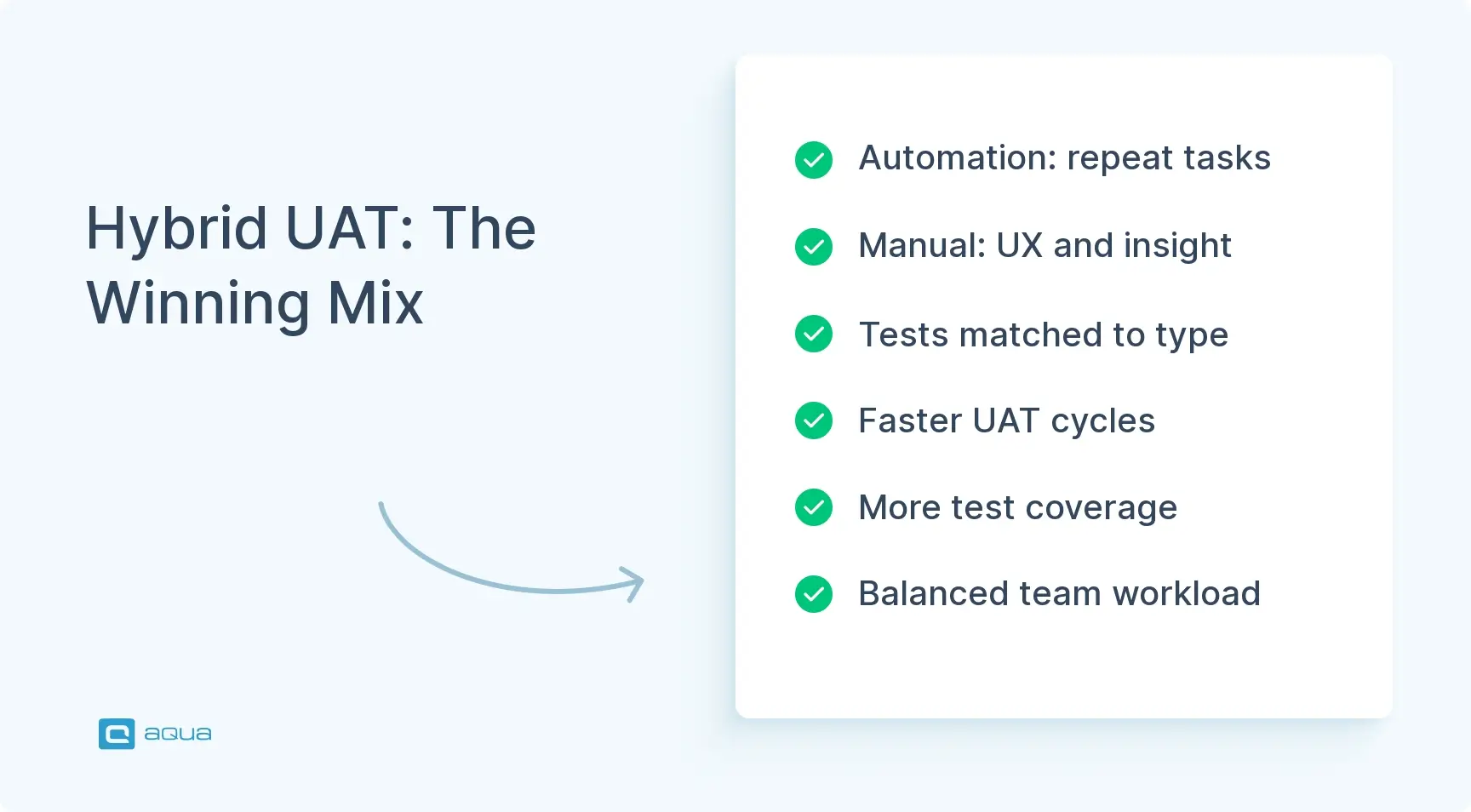Key Takeaways
- User Acceptance Testing (UAT) verifies that software meets business requirements through real users testing real-world scenarios before deployment.
- Manual UAT provides human insight into usability issues and workflow problems but suffers from time constraints, inconsistency, and scaling challenges.
- Automated UAT delivers speed, consistency, and large-scale testing capabilities but requires technical expertise and misses the intuitive human element.
- A hybrid approach combines both methods strategically, using automation for repetitive testing and manual testing for exploratory scenarios requiring human judgment
- The optimal balance between manual and automated UAT depends on project timelines, technical complexity, requirement stability, and team capabilities.
Choosing between manual and automated UAT isn’t an either/or decision – successful teams use both approaches to cover each other’s blind spots. Discover how to implement this balanced strategy 👇
What is User Acceptance Testing?
User Acceptance Testing (UAT) is the final phase of the software testing process where actual users test the software to verify it works as intended in real-world scenarios. Unlike other testing phases that focus on finding bugs or technical issues, UAT confirms that the software delivers on its business requirements and meets user expectations.
UAT happens after all the technical testing is complete but before your software goes live. It’s where real users determine whether your application actually helps them do their jobs or just creates more work.
The people doing UAT aren’t professional testers hunting for technical bugs. They include:
- End users who will interact with your system daily
- Business stakeholders who understand operational requirements
- Client representatives with authority to approve final delivery
These are the people who know whether your software makes sense in the real world.
UAT succeeds when several elements come together effectively. You need test scenarios based on actual user workflows, not theoretical use cases. Acceptance criteria must be defined and agreed upon before testing starts, preventing arguments about what constitutes acceptable performance.
Key success factors include:
- Representative test data that reflects the messy reality of production information
- Adequate training for business users unfamiliar with formal testing processes
- Clear documentation that captures not just results but user feedback about workflow efficiency
- Realistic timelines that account for users’ other job responsibilities
When UAT works properly, users can confidently say your system does what they need it to do. When it fails, you risk deploying software that technically functions but frustrates the people who have to use it daily. This leads to workarounds, poor adoption, and projects that succeed technically but fail practically.
Manual User Acceptance Testing: Advantages and Disadvantages
Manual UAT means real people manually clicking through your application to validate it works as expected. Business users follow test scripts, explore features, and provide feedback based on their actual experience using the software.
The Human Touch Advantage
Manual testing leverages what technology can’t replicate: human intuition and real-world perspective. When users physically interact with your software, they spot usability problems that scripts miss.
Key advantages include:
- Usability insights like confusing navigation or unclear labels that feel wrong to actual users
- Immediate feedback on user experience and workflow efficiency
- Intuitive testing that adapts when users notice something unexpected
- Real-world context about whether the software actually helps or hinders daily work
Imagine you work in a healthcare company. During manual UAT, you can find out that your new patient system might require too many clicks for common tasks. This would slow you down during busy shifts. Automated tests, for example, would never have flagged this workflow inefficiency.
Flexibility and Accessibility
Manual UAT requires minimal technical setup. Business users can start testing immediately without coding knowledge. Tests adapt quickly as requirements change. Edge cases get explored naturally without script modifications.
The Drawbacks of Manual Testing
Manual testing brings significant challenges that affect project timelines and quality.
Time and consistency problems plague manual approaches. Large test suites take days or weeks to execute. Different testers interpret steps differently. Human error leads to missed steps or inconsistent execution. Fatigue causes overlooked issues.
Scalability becomes a bottleneck as applications grow. An example could be a financial services firm. As your application expands, you can find your manual UAT cycles stretched from one week to nearly a month. Extended timelines delay critical features and threaten your competitive position.
Documentation and repeatability create ongoing headaches. Manual tests rely heavily on detailed documentation. Reproducing exact test conditions proves challenging. Test results often lack the precision needed for complex issue resolution.
UAT is when you ship stuff so frequently to your customers that they feel they have to do your testing job for you!
Manual UAT works well for usability validation and initial feature exploration, but struggles with repetitive testing and large-scale validation requirements.
Automated User Acceptance Testing: Pros and Cons
Automated UAT flips the script entirely. Instead of users clicking through scenarios, software handles the testing while you grab coffee. Scripts execute predefined test cases, validate expected outcomes, and report results without human intervention.
Speed and Efficiency Benefits
The speed difference is genuinely impressive. Tests that eat up your entire afternoon finish during a lunch break. That regression testing you’ve been dreading? Done overnight while you sleep. Your development team gets feedback in hours instead of days, so they can fix issues while the code is still fresh in their minds.
This isn’t just about saving time. Fast feedback loops change how teams work. Developers can iterate quickly instead of waiting days to learn whether their changes broke something important.
Consistency and Reliability
Here’s where automation really shines. Automated tests never have bad days or skip steps because they’re tired. Every test runs exactly the same way without the variability that comes with different people interpreting instructions differently.
What this means for your testing:
- Perfect repeatability so you can trust that results reflect actual software behaviour
- Detailed logs that capture exactly what happened at each step
- Complex validations that would be error-prone for humans to perform manually
- Reliable debugging information when something does go wrong
Scale and Coverage
As your application gets bigger and more complex, automation becomes your best friend. You can run thousands of test cases without burning out your team. Testing across multiple browsers and devices happens simultaneously. Coverage that would require an army of manual testers becomes routine.
Finding the right balance between manual and automated UAT doesn’t have to be a constant struggle. While evaluating both approaches, many teams discover they need a unified platform that accommodates both testing methodologies without compromise. This is where aqua cloud shines.
Our test management system seamlessly integrates manual and automated testing in one centralised environment, allowing your team to leverage the human intuition of manual testing alongside the consistency and speed of automation. With aqua’s flexible approach, you can build test cases that combine manual steps with automated scripts, create reusable components that work across both methodologies, and generate unified reports that give stakeholders complete visibility. The platform integrates with leading automation tools like UFT, Ranorex, and SoapUI while providing robust manual test execution capabilities—all managed through a single, intuitive interface. Integrations like Jira, Confluence, and Azure DevOps are the cherry on top of your toolkit. Teams using aqua report saving over 6 hours per week on test management tasks, allowing them to focus more on discovering critical issues rather than managing test infrastructure.
Save 6+ hours weekly with a unified manual and automated testing management
The Challenges of Automation
Automation sounds perfect until you run into its limitations. The reality is more complicated than the sales pitches suggest.
The upfront investment hits harder than expected. Setting up meaningful automation requires serious time and technical expertise. Your scripts need constant babysitting as the application changes. What started as a simple test suite can evolve into a complex technical project that needs its own maintenance team.
Technical barriers keep business users on the sidelines. Most of your domain experts can’t create or modify test scripts. You become dependent on developers or technical testers who understand code but might miss the business context that matters for realistic testing.
Automation misses the human element completely. Scripts validate exactly what they’re programmed to check and nothing more. They can’t notice when something feels wrong or when a workflow seems unnecessarily complicated.
Imagine you work for a retail company that has automated checkout testing. Your scripts dutifully verify that items appear in carts and the payment process correct. Everything passes beautifully. But then real customers start complaining that items disappear from their carts if they take too long reading payment options. Your automated tests missed this completely because they execute steps at consistent intervals. Human testers would have caught it during natural exploration because people actually pause to read confirmation messages and think about purchase decisions.
Automation excels at the heavy lifting of repetitive validation, but it can’t replace the insights that come from real humans using software the way humans actually behave.
Combining Manual and Automated Testing: A Hybrid Approach
Why choose between manual and automated UAT when you can use both strategically? The most effective teams stop treating these approaches as competitors and start using them to cover each other’s blind spots.
The Best of Both Worlds
Smart QA teams are discovering that manual and automated testing work better together than apart. Let automation handle the repetitive grunt work while humans focus on the nuanced evaluation that requires judgment and intuition.
This means automation tackles:
- Regression testing that needs to run after every code change
- High-volume scenarios that would exhaust manual testers
- Cross-browser compatibility across dozens of environment combinations
- Core functionality verification that follows predictable patterns
Meanwhile, manual testing focuses on:
- Exploratory scenarios where users might discover unexpected issues
- Usability evaluation that requires a human perspective on workflow efficiency
- Complex business processes that need domain expertise to validate properly
- Edge cases that emerge during natural user interaction
Strategic Test Distribution
Different types of tests naturally align with different approaches based on their characteristics and requirements.
| Test Type | Best Approach | Rationale |
|---|---|---|
| Regression Testing | Automated | Repetitive, consistent, high volume |
| Core Functionality | Automated | Critical paths need frequent verification |
| Complex Workflows | Manual | Require human judgment and context |
| Usability Testing | Manual | Subjective assessment needed |
| Cross-browser/device | Automated | Too many combinations for manual testing |
| Exploratory Testing | Manual | Unscripted discovery of potential issues |
Implementation Strategies
Making hybrid UAT work requires more than just dividing tests between manual and automated buckets. You need thoughtful coordination between both approaches.
Start by mapping all your test scenarios and evaluating which approach makes the most sense for each one. Prioritise automation for stable features that get tested repeatedly. Create collaboration between your manual and automation testers so insights from human testing can inform automated script development.
Establish clear handoffs between automated and manual testing phases. Use automation to generate test data that manual testers can leverage. This prevents manual testers from spending time on setup work that automation handles more efficiently.
Real Implementation Success
A healthcare software provider found their sweet spot by running automated tests nightly to verify core functionality across their patient portal. Manual testers focused their energy on clinical workflows that required medical domain knowledge to validate properly. The result was UAT cycles that finished 40% faster with higher quality outcomes and better satisfaction from clinical users who felt the testing actually reflected their daily work reality.
Getting Started with Hybrid UAT
Moving to a hybrid approach doesn’t mean overhauling your entire testing process overnight. Start by assessing your current approach and identifying the biggest pain points. Which scenarios feel tedious to test manually? Which tests require human insight that automation can’t provide?
Begin with small automation experiments on your most repetitive, stable test cases while maintaining your existing manual testing. As you build confidence with automated tools, gradually expand coverage. Continuously evaluate whether the balance between manual and automated testing is serving your actual needs rather than following a rigid formula.
The goal is to create a testing approach that maximises both efficiency and insight, giving you confidence that your software works technically and practically for the people who need to use it.

Finding Your Optimal UAT Balance
There’s no universal formula for the perfect manual-to-automated testing ratio. Your optimal balance depends on project realities that change from one release to the next.
Assessing Your Project Needs
Several factors influence whether manual or automated testing makes more sense for your specific situation. Tight project timelines often push teams toward automation to speed up testing cycles. Budget constraints might require starting with manual approaches that don’t need upfront automation investment.
Key considerations include:
- Technical complexity of your application and whether automation can handle the scenarios effectively
- Stability of requirements since frequently changing features favor manual testing initially
- User experience criticality where UX-focused applications need significant human evaluation
- Team capabilities and whether you have automation skills available now or need to build them
Decision Framework
When you’re evaluating specific features or test scenarios, these questions help determine the best approach:
Frequency and stability questions:
- How often will this feature need retesting during development and maintenance?
- How stable is this functionality likely to remain over time?
Complexity and criticality questions:
- How complex is the user interaction and decision-making involved?
- How critical is this functionality to business success if it fails?
Resource and capability questions:
- Do we have the technical skills to automate this testing effectively?
- Would automation setup time be justified by repeated use?
Progressive Implementation
Most successful teams don’t try to solve the manual versus automated question all at once. They start somewhere practical and evolve their approach based on what they learn.
A typical progression begins with primarily manual UAT while your team builds automation capabilities on the side. Gradually automate the most stable, repetitive test cases that deliver clear time savings. Continuously refine the balance based on project feedback and results.
Adapt your mix as both your application and team mature. Features that started as manual testing candidates might become good automation targets once they stabilise. New team members might bring automation skills that change what’s possible.
The goal is to find a sustainable balance that delivers reliable validation without overwhelming your team or budget. This balance will shift as your project evolves, and that’s perfectly normal.
As you work to find your optimal UAT balance between manual and automated testing, having the right tools becomes essential. aqua cloud is specifically designed to eliminate the either/or decision by providing a comprehensive test management platform where both approaches can coexist and complement each other.
aqua cloud allows you to build test cases with both manual and automated steps, use AI to generate test cases, test data, and requirements in seconds, and maintain complete traceability from requirements to results. The flexibility of aqua lets you start with primarily manual UAT while gradually incorporating automation: exactly following the progressive implementation pattern described above. With features like parameterisation that works across both test types, distributed execution agents for automated tests, and unified reporting, aqua becomes the central hub for your entire testing strategy. Organisations using aqua have cut release cycles by hours per sprint while simultaneously improving test coverage and quality. The platform’s “banking-grade” traceability also simplifies compliance requirements, saving 10-20 hours during regulatory reviews. aqua’s native Capture integration is the best solution for bug reporting and user feedback, streamlining devs-QA relationships for good. Rather than struggling with disconnected tools for manual and automated testing, why not bring everything together in one powerful platform that adapts to your evolving testing needs?
Cut release cycles 40% per sprint with aqua's unified test management
Conclusion
The choice between manual and automated UAT isn’t really a choice at all. Both approaches solve different problems, and the most effective teams use them together strategically. Manual testing catches the usability issues and workflow problems that only humans can spot. Automation handles the repetitive validation that would otherwise burn out your team. Start by understanding what each approach does best, then build a testing strategy that leverages both strengths. Your users will get better software, and your team will spend their time on testing work that actually requires human insight.


















